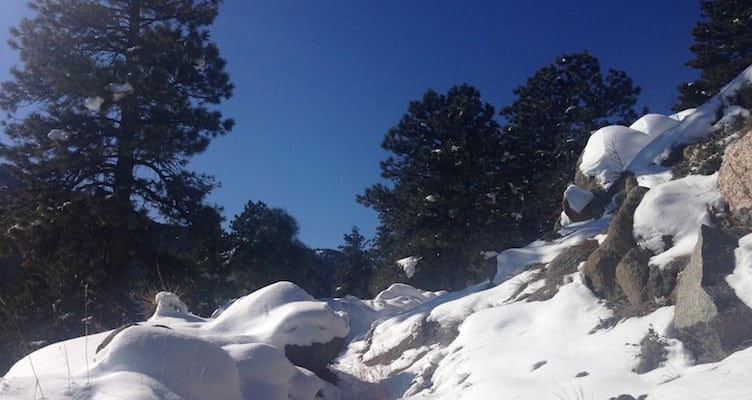
Any winter walk in Boulder has the potential to feel epic. With the possibility of snow, ice, wind, and wildly varying temps, even a stroll through Pearl Street Mall can turn into an adventure. But don’t let life’s daily challenges keep you from getting out there for some real adventure.
Even with unpredictable weather and fewer daylight hours, awesome challenges await you on the trails. And in spite of what you’ve seen on Instagram lately, you don’t need to trudge all the way to Indian Peaks and beyond. This is great news, because staying local means less travel on icy roads and less time sitting in traffic. Staying local means you can reserve all your time and energy for the hike itself. Staying local means you may even find yourself with extra time to celebrate over pizza and beer. I think you see where I’m going with this. Now that we’re all on the same page, let’s talk about the hike.
The ideal winter hike makes the most of the season’s inherent challenges, without being so difficult that it’s dangerous or borderline impossible. Enter the Boulder Winter Trifecta. As the name suggests, it encompasses the Boulder range’s three major peaks: Green Mountain (8,144 feet), Bear Peak (8,461 feet), and South Boulder Peak (8,549 feet). In milder seasons, this hike is a fairly strenuous undertaking. In the winter months, that’s when it becomes epic. Shrinking daylight, icy slopes, and blustery winds will threaten to thwart you, but triumph you will! Read on for all the gear recommendations, trail information, and insider tips to tackling this badass winter hike conveniently located in our own little bubble.
Who
So how do you know if you’re Winter Trifecta material? If you hike or run on a regular basis and you’ve bagged a few peaks in your day, then you’ve got what it takes. If you’re mostly a fair weather hiker, that’s okay. Get out there and do a few practice hikes in ice and snow beforehand, and you’ll be ready to go. Suffice it to say, this is not an ideal hike for most out-of-towners or newbies.
What
Winter hiking can really beat you up. It’s amazing how different a mountain can feel when it’s covered in snow and ice. Not only is it tougher on your body, but it’s a lot riskier, too. Thankfully, 90% of successful winter hiking comes down to preparedness. (And in case you’re wondering, the other 10% is the pizza you eat afterward.) Below is a list of gear that will help keep you safe and make your trek a pizza-worthy success.
- A good sturdy pack (preferably water-resistant). Keep in mind you’ll be toting more stuff in January than you did in June.
- Lots of warm, wicking layers. You can always take them off, but you can’t add more once you’re out there.
- Hat and gloves (and an extra pair of gloves ideally)
- Extra pair of socks
- Plenty of water (8-10 ounces per hour). We all have a tendency to drink less than we need in cold weather, but stay on top of it or you may regret it later on.
- Hearty snacks (and don’t forget about caffeine if you’re into that sort of thing)
- Foot traction. There are many options out there. Go for something with a lot of grip (Microspikes, for example) because the upper portions of these peaks are steep.
- Trekking poles for balance and stability (they weigh next to nothing and can always be hooked onto your pack if you don’t need them)
- Headlamp (even if you don’t plan to be out there in the dark)
- Fully-charged cell phone
- Basic First Aid Kit
Be sure to tell others what your plans are for the day and when you expect to be back. We tend to be a little cavalier about this when hiking locally, but winter conditions can be a game changer. Take this extra precaution.
Where
Your bag is packed; you’re ready to go. So where exactly do you go? Whether you choose to begin on the north end with Green Mountain, or the south end with South Boulder Peak, is up to you. As it’s laid out here, you’ll be starting off lower and building up elevation more gradually. And then you have the pleasure of topping out on the highest peak. But if you do it in reverse, you’ll get the toughest climb out of the way early. If you want to be the most Boulder-y Boulderite in Boulder, why not try it both ways this season? Decisions, decisions. However you decide to tackle it, below is the peak-by-peak breakdown of the trails. Consult OSMP.org for maps and possible trail closures.
Green Mountain: Begin at the Chautauqua Trailhead. Take Baseline Trail to the Saddle Rock Trail. After 1.2 miles, turn left on E.M. Greenman and follow to the summit. Enjoy righteous summit selfies. Check out the summit dial to learn the names of the snow-capped peaks to the west.
Bear Peak: Head down Green Mountain West Ridge Trail for 0.5 miles to Green Bear Trail. Beautiful Green Bear rolls south for 1.5 miles to the junction with Bear Peak West Ridge and Bear Canyon. Take the long and steep Bear Peak West Ridge to the top. Be careful on Bear’s rocky, exposed summit – it’s not for the faint of heart.
South Boulder Peak: Turn back to the west side of Bear’s summit, and head south for 0.6 miles to the summit of South Boulder Peak. Soak in the 360-degree panoramas and bask in your success, but not for too long, because Shadow Canyon awaits you. Return the way you came till you reach the junction with Shadow Canyon Trail. Turn right and head down Shadow Canyon to the Mesa Trail. Watch your footing on the steep, flood-ravaged trail. Finish at the South Mesa Trailhead.
This hike is approximately 10.5 miles long with about 5,000 feet of elevation gain.
Other Stuff
Remember this quote from Hervey Voge: “The mountain will always be there; the trick is to make sure you are, too.” If your safety becomes compromised due to trail conditions or inclement weather, please turn around. Tomorrow is another day, and we want you to be around for many more badass hikes in the future.
Happy (epic) trails, Boulderites!
Photo credit: Alli Fronzaglia — all rights reserved




